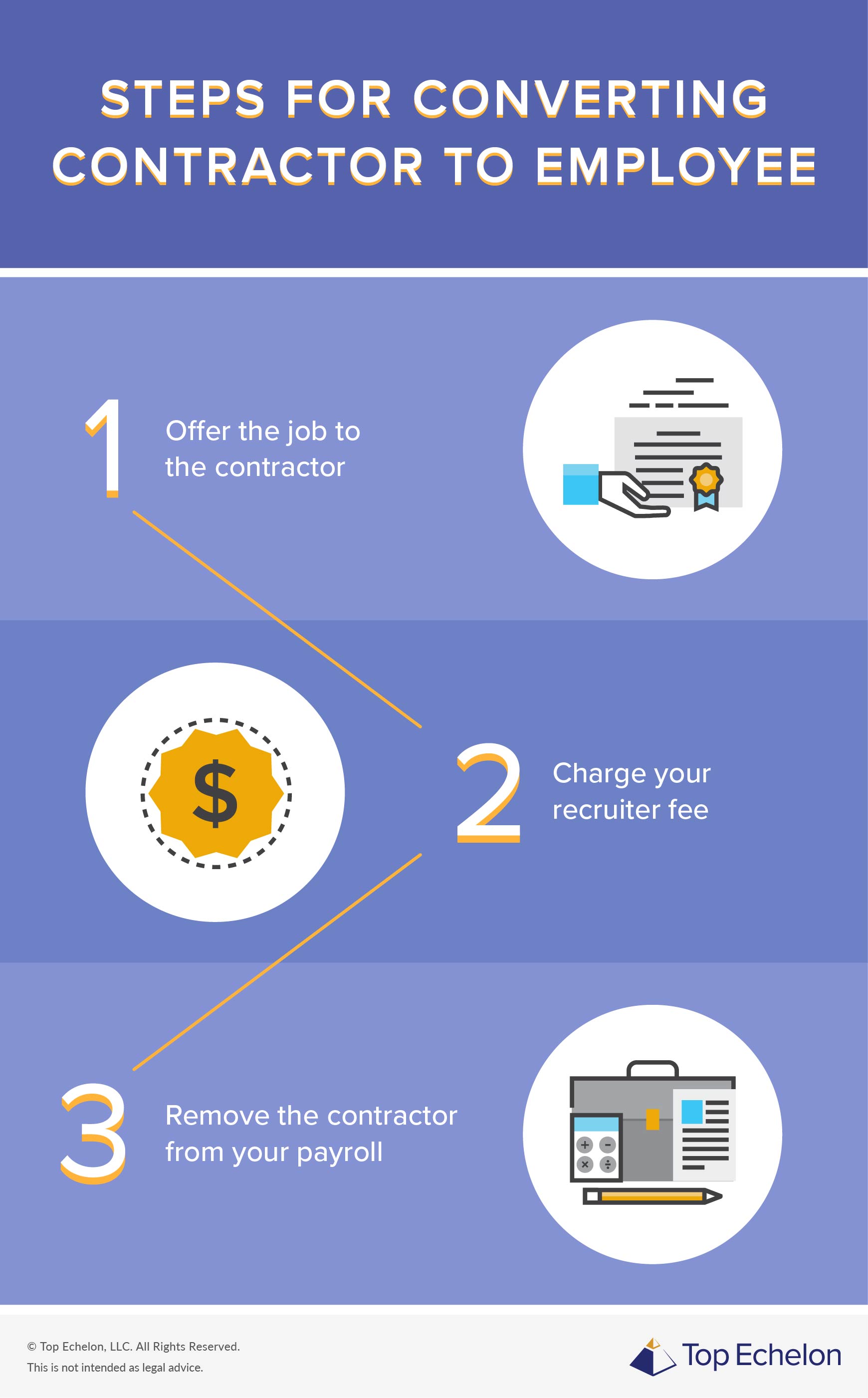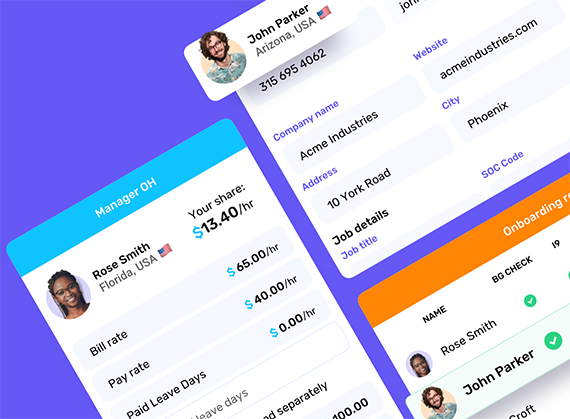You place a contract worker at a client company and hear what every recruiter wants to hear: your client loves the worker.
Sometimes, a client might like a contract worker so much that they want to extend a full-time job offer. This is called “temp to perm conversion” or “try before you buy,” but “contract to direct hire conversion” is the industry standard phrase when transitioning a contract worker to a direct hire of the client company. So how does converting from contractor to employee work?
Contractor to direct hire conversion
When you place a contract worker at a client company, you agree to responsibilities such as running payroll and administering benefits, but you also become the employer of record. Your client pays you according to your hourly bill rate, which covers the contractor’s wages, employment taxes, back-office fees, benefit contributions, and your recruiter profit. You could avoid those tasks by using an employer of record (EOR) as well, but either way, it’s not the client’s responsibility.
But when your client decides to extend a full-time offer (direct hire) to your contract worker, they take on the role of employer of record. The contractor to direct hire conversion removes you or your EOR as the employer.
Converting from contractor to employee also means you likely receive a conversion fee. When placing the contractor, did you and your client discuss the possibility of hiring the worker full-time at some point in the future? If so, you probably have some conversion fee language in the contract. Before the actual conversion takes places, there are a few things to consider.
When does a contractor become a direct hire?
In the technical and professional realm, the common contract assignment lengths include three, six, nine, or 12 months. But, converting from contractor to employee does not always happen after a specific period of time. Each situation is different, so it is recommended that you have contractual language in place.
If you and your client agree that a contractor to direct hire conversion is possible, include the time frames in your contract-to-hire agreement. One recommendation is to prorate your full direct hire fee over a 12-month period. For example, after seven months of work, you would receive 5/12 of the 25% direct hire fee, and all fractions for the 12-month period would be referenced in the contract.
Another option is to give the client a credit for every hour a contractor worked under the contract assignment. For example, if you earn $12.00 for every hour the contractor works during the contract assignment, the conversion fee could say, “a fee of 25% of the first year compensation, less a credit of $6.00 per hour for every hour worked under the contract.”
What are some guidelines to transition a worker?
When transitioning a contract worker to full-time employee status, the client should address things like: transitioning the employee to their payroll and extending employee benefits to the worker (e.g., paid time off, health insurance benefits, and retirement plan options).
Depending on your client’s business policy, they may give their newly transitioned employee access to to the above benefits immediately upon hire or put them through a transitionary period.
Steps for converting from contractor to employee
Once your client decides to convert a worker from contractor to employee, the transition process begins. Use the following three steps for contractor to direct hire conversion.
1. Offer the job to the contractor
Contractors are not obligated to accept full-time job offers from a recruiter’s client. Your worker may have already embarked on switching from full-time to contractor and prefer contract work. Before assuming a contractor will convert to an employee at your client’s company, your client should formally offer them the position.
Some businesses require contractors to re-apply for the position they currently have before offering them the job. The contractor may need to put in writing why they want the job or feel qualified. Your client may also require the contractor to take a drug test or complete a background screening. Remember, this is the first time the contractor will be on your client’s payroll. Your client has a responsibility to do their due diligence when hiring.
If your contractor accepts the job offer, determine when their last day as a contractor is, as well as their first day as an official employee at your client’s company.
Most contractors earn an hourly wage. Your client may convert the contractor from hourly-to-salary and provide a different compensation package. The client should discuss any changes in wages and other benefits with the contractor. Additionally, the recruiting firm usually earns a conversion fee for allowing the employee to be hired by the client. Conversion fee agreements can vary, but we offer some free example conversion fee templates to help steer you in the right direction.
Your client may also ask their new hire to sign a contract or at-will employment doctrine.
2. Charge your recruiter fee
Did the contractor accept your client’s full-time job offer? If so, you will likely collect additional recruiter fees.
When you offer contract staffing, you earn an hourly recruiter fee (profit) for every hour your contractor works at your client company. And when that contractor is hired directly, you will earn an additional contract-to-direct hire fee.
So, once you calculate your contract-to-hire conversion rate all you need to do is send an invoice to the client for the negotiated dollar amount.
3. Remove the contractor from your payroll
When your contract worker transitions to a full-time employee at your client’s company, the contractor is no longer on your firm’s payroll, and you can stop distributing wages, collecting payroll taxes, and distributing benefits to them. But, you need to flag them as a terminated employee. Also, keep in mind that you will still need to issue year-end Forms W-2 and ACA compliance forms.
There are other things to consider if your contractor had benefits, too—things like notifying the specific medical, dental, and vision providers; addressing COBRA compliance; and telling the retirement plan administrator if that benefit existed for the contract worker.
For those of you who outsource the employer of record (EOR) responsibilities for contract workers, all of the transition tasks should be handled by your contract staffing back-office provider.






